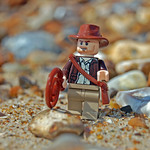Archaeology is the search for fact… not truth. If it’s truth you’re looking for, Dr. Tyree’s philosophy class is right down the hall. … So forget any ideas you’ve got about lost cities, exotic travel, and digging up the world. We do not follow maps to buried treasure, and ‘X’ never, ever marks the spot. Seventy percent of all archaeology is done in the library. Research. Reading.
indiana jones
Before my career in educational technology I trained as an archaeologist, and in reflecting on my experiences in the MET, I see connections with this earlier work. As an archaeologist sifts through layers of earth, unearthing artifacts and evidence, the process of building the portfolio has allowed me to dig deeper into my own learning journey.
A portfolio is in some ways like a museum. It contains objects, arranged by a curator, to tell a story. Stories don’t reveal ‘the truth’, and neither does an archaeological site (as Indiana Jones famously observed).

So this is my story.
It describes the layered history, the stratigraphy behind my ideas regarding educational technologies. It highlights the tools that have helped me understand how technology can be used to support and enrich educational experiences. It showcases the goals I set myself and the artifacts I have made during my time in the UBC Masters of Educational Technology program, for which this represents a capstone artifact (a meta-artifact, if you will). It tries to catalog as a series of field notes my developing ideas as I curated these artifacts.
And it looks to the future: It’s often said that studying the past is a way to understand and influence the possible futures that lie ahead. As I move on from the MET, my experiences will continue to contribute to the work I undertake.
Wayfinding
Select the menu button at the top-left of the page or use the links in the footer (below) to explore the portfolio.